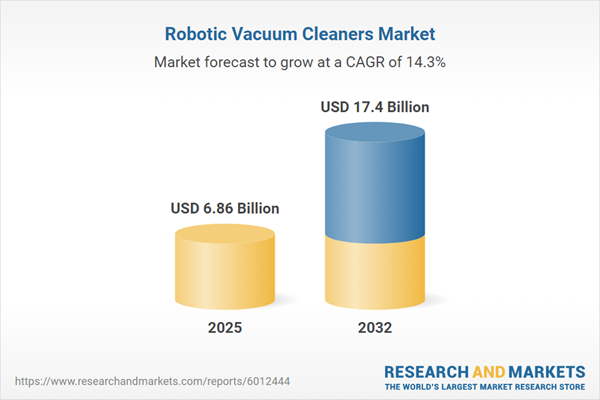Speak directly to the analyst to clarify any post sales queries you may have.
The robotic vacuum cleaners market is rapidly reshaping how businesses and households automate cleaning, enabling organizations to elevate operational efficiency, optimize resource use, and address growing regulatory and sustainability expectations. Senior decision-makers are leveraging this transformation to align facility management with strategic priorities for compliance and productivity.
Market Snapshot: Robotic Vacuum Cleaners Market
Momentum in the robotic vacuum cleaners market continues to accelerate, as global revenues are projected to grow from USD 5.99 billion in 2024 to USD 6.86 billion by 2025. The market is achieving a robust compound annual growth rate (CAGR) of 14.25%, positioning the sector for significant expansion and long-term value through 2032, where revenues are forecast to reach USD 17.40 billion. Drivers of this strong trajectory include advancements in artificial intelligence, sensory technologies, and autonomous navigation. Robotic vacuums increasingly integrate with smart building infrastructure, responding to the needs of businesses aiming for improved automation, cost efficiency, and sustainability within facility operations.
Scope & Segmentation
This executive market analysis delivers strategic decision support through a detailed segmentation of product offerings, technologies, channels, and regional considerations, helping leadership teams direct investments precisely and manage risk.
- Product Type: Integrated mopping options and stand-alone vacuum systems provide tailored cleaning for varied flooring types, ensuring compatibility with both commercial and residential environments.
- Price Range: Entry-level, mid-tier, and premium robotic vacuums accommodate diverse organizational budgets and performance expectations, helping optimize capital allocation across facilities or portfolios.
- Technology: Essential innovations such as laser distance sensors, vision-based simultaneous localization and mapping (VSLAM), and advanced navigation algorithms deliver accurate mapping and efficient coverage, supporting deployment in large-scale or complex environments like offices, hospitals, or retail spaces.
- Application: Flexible operation on surfaces including carpets, hardwood, tile, and composite flooring addresses stringent hygiene requirements and supports proactive, scheduled maintenance for environments with demanding cleanliness standards.
- End User: Facility managers benefit from scalable, robust platforms suitable for expansive properties, while residential users are drawn to intuitive controls and simplified automation that reduce hands-on oversight.
- Sales Channel: Distribution through retail chains, supermarkets, direct digital platforms, multi-vendor marketplaces, and specialized ecommerce sites offers wide purchasing options and access to product upgrades and after-sales support.
- Regions: The market encompasses the Americas, EMEA, and Asia-Pacific, reflecting diverse regulatory requirements, procurement approaches, and competitive dynamics that shape investment and adoption strategies.
- Key Companies: Strategic benchmarks are established by leading manufacturers including iRobot Corporation, Ecovacs Robotics, Roborock Technology, SharkNinja, Dyson Technology, Samsung Electronics, ILIFE, Midea Group, LG Electronics, and Neato Robotics.
Key Takeaways: Strategic Insights for Decision-Makers
- Automation provided by robotic vacuum cleaners enables ongoing facility upkeep, raising operational consistency for large-scale and high-traffic environments across commercial and residential sectors.
- Seamless integration with smart building platforms supports ongoing compliance and rapid process adjustments, positioning organizations for smoother multi-site management and adaptation to industry requirements.
- AI-driven systems and intelligent sensor integration enable predictive maintenance, thereby reducing system downtime and supporting long-term infrastructure resilience.
- Diversified and direct sales channels present wider procurement choices and create feedback pathways, empowering suppliers to refine product performance and meet evolving end-user expectations.
- Customization for local regulatory landscapes enables organizations to address compliance challenges while aligning operations with global standards for quality and sustainability.
- Resilient supply chain strategies, such as diversified sourcing and supplier flexibility, help companies maintain continuity in the face of fluctuating component availability or disruptions in the global electronics sector.
Tariff Impact and Supply Chain Adaptation
Recent adjustments to U.S. tariff policies affecting electronic and sensor components are prompting leading robotic vacuum manufacturers to diversify their sourcing models and establish partnerships with local suppliers. This approach supports innovation in procurement and product design while increasing logistics reliability and agility to manage changes in global trade activity.
Methodology & Data Sources
This market overview integrates direct interviews with industry stakeholders and end-users. Secondary sources such as regulatory documentation and audited company reports supplement primary findings. Peer review and methodological triangulation underpin reliable and actionable intelligence for senior leadership.
Why This Report Matters
- Enables detailed identification of growth opportunities through comprehensive segmentation and strategic channel analysis, supporting organizational expansion and investment optimization.
- Equips decision-makers with essential intelligence on industry regulations and best practices, aiding in proactive risk mitigation and the formulation of robust continuity plans.
- Provides insight into anticipated automation market shifts, helping organizations uphold a competitive edge amid technological and regulatory transformation.
Conclusion
Sustained leadership in the robotic vacuum cleaners market relies on continual technology advancement and resilient supply chain strategies. Monitoring regulatory trends and anticipating market needs will support ongoing organizational relevance and value creation in this dynamic sector.
Additional Product Information:
- Purchase of this report includes 1 year online access with quarterly updates.
- This report can be updated on request. Please contact our Customer Experience team using the Ask a Question widget on our website.
Table of Contents
3. Executive Summary
4. Market Overview
7. Cumulative Impact of Artificial Intelligence 2025
Companies Mentioned
The companies profiled in this Robotic Vacuum Cleaners market report include:- iRobot Corporation
- Ecovacs Robotics Co., Ltd.
- Beijing Roborock Technology Co., Ltd.
- SharkNinja Operating LLC
- Dyson Technology Limited
- Samsung Electronics Co., Ltd.
- ILIFE
- Midea Group Co., Ltd.
- LG Electronics Inc.
- Neato Robotics, Inc.
Table Information
| Report Attribute | Details |
|---|---|
| No. of Pages | 193 |
| Published | October 2025 |
| Forecast Period | 2025 - 2032 |
| Estimated Market Value ( USD | $ 6.86 Billion |
| Forecasted Market Value ( USD | $ 17.4 Billion |
| Compound Annual Growth Rate | 14.2% |
| Regions Covered | Global |
| No. of Companies Mentioned | 11 |









